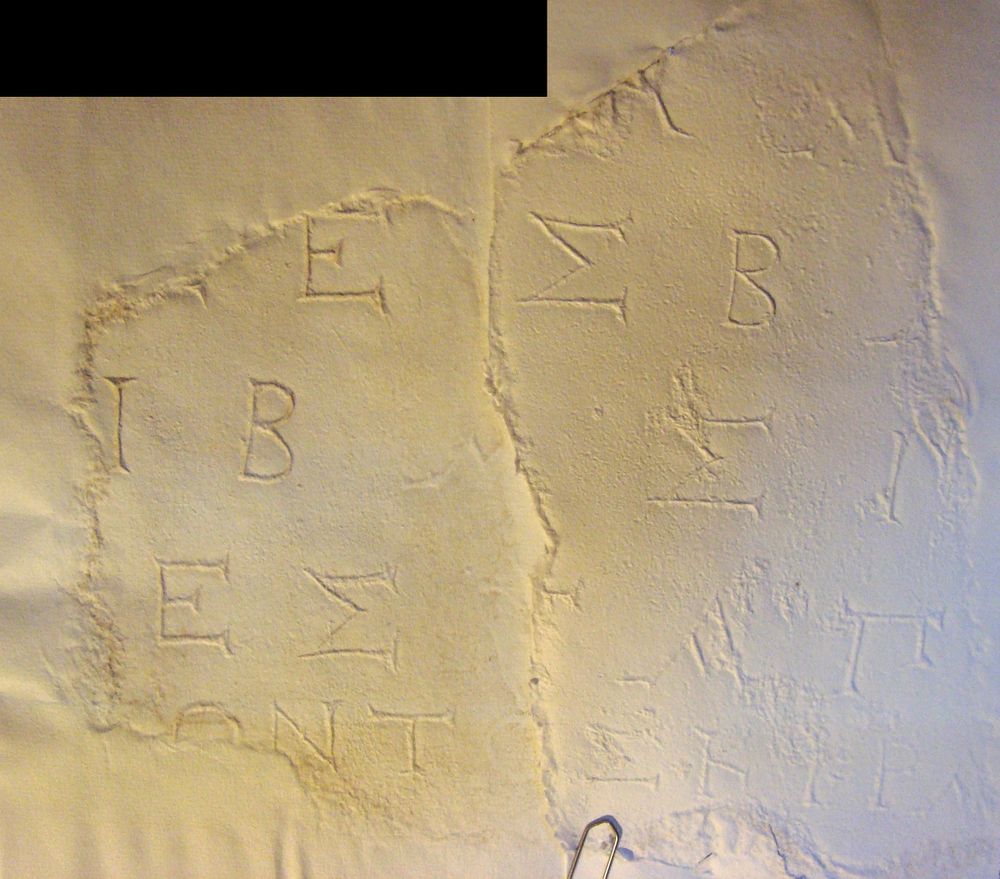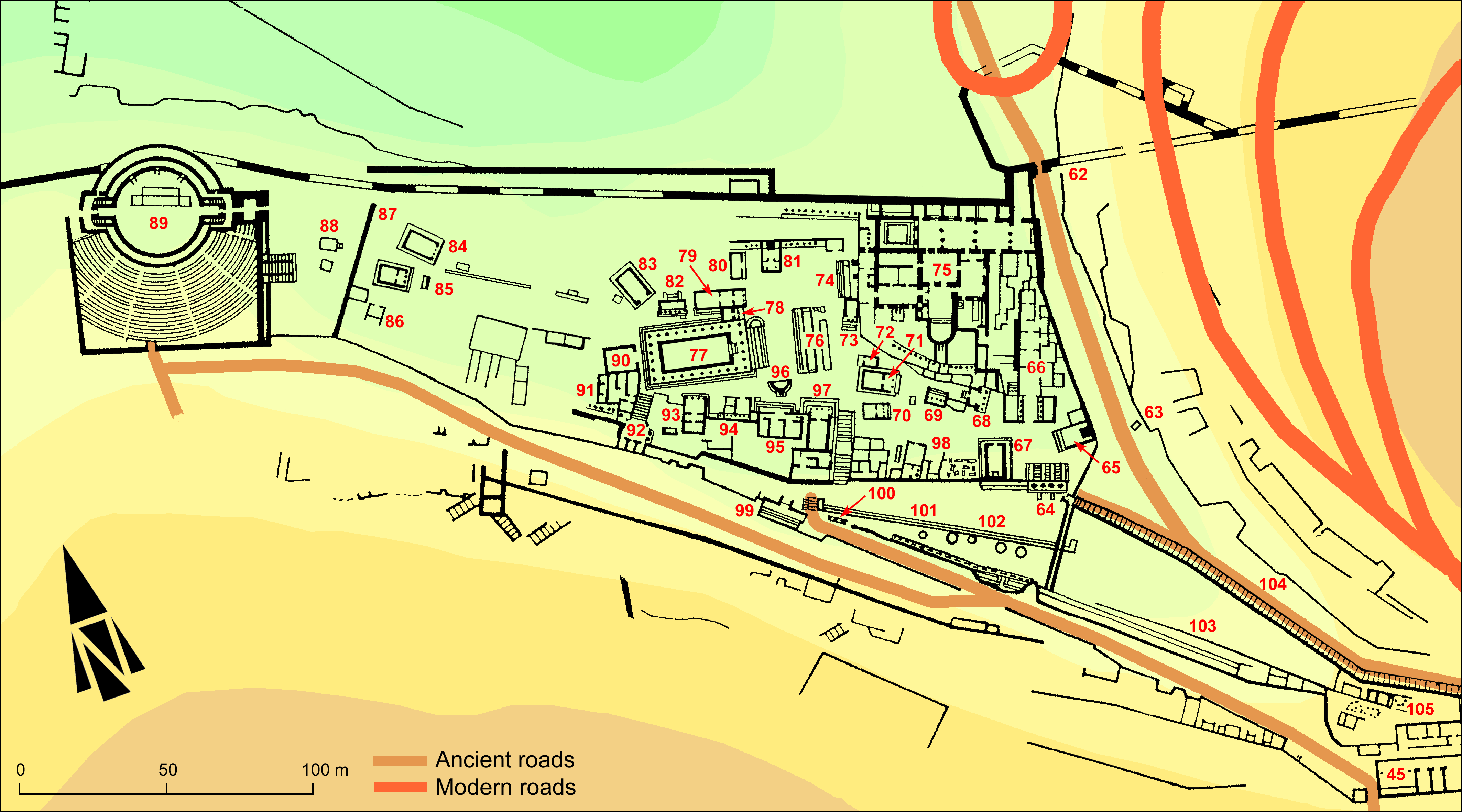EpiDoc XML:
IGCyr0634002
Trismegistos ID:
6102
Source description
Support: Two adjacent fragments of a white marble panel broken on top and at right; bottom edge partly preserved, left edge recut (w: 0.25 × h: 0.24 × d: 0.055).
Layout: Inscribed on the face.
Letters: 0.02-0.025 at lines 1 to 4, 0.015-0.019 at line 5; slight serifs; alpha with a dropped bar, non-slanting sigma.
Date: Probably between 144 and 116 BC (lettering, prosopography).
Findspot: Found between 1929 and 1930 at Cyrene ➚: Sanctuary of Apollo, Temple of Apollo.
Place of origin: Findspot.
Last recorded location: Cyrene Museum, 55+185. Seen by C. Dobias-Lalou in 1979 in Shahat: Cyrene Museum.
Text constituted from: Transcription from stone (CDL).
Bibliography
Fraser 1958, pp. 116-118, n. 9, pl. XIII, 9, whence SEG, 18.735; IGCyr 063400 ➚. Cf. Laronde 1987, p. 453, footnote 228. Adams 2002, p. 40 and Dobias-Lalou, BE, 2005.622, whence SEG, 53.2042; Rosamilia 2014, n. 10, whence SEG, 64.2012; Rosamilia 2023, p. 184, footnote 38.
Text
Apparatus
7: [---]υ̣οντος: [---]οντος Rosamilia 2014; [---μέδ]οντος Fraser 1958
French translation
(scil. La statue de) [[---](scil. fils de)[---]] (scil. a été consacrée), par [---] fils de [--- en raison de son dévouement] envers le roi [Ptolémée, Dieu Evergète,] envers la reine [Cléopatre, son épouse et leurs] enfants.
[Oeuvre de ---] fils de [---]ôn cyrénéen.
English translation
(scil. The statue) of [---], [son of ---] (scil. was dedicated) by [---] son of [--- on account of his goodwilling] towards king [Ptolemy, God Euergetes,] and queen [Cleopatra, his wife as well as their] children.
[Made by ---] son of [---]on, a Cyrenaean.
Italian translation
(scil. La statua) di [---], [figlio di ---] (scil. è stata dedicata) da [---] figlio di [--- in considerazione della sua dedizione ] verso il re [Tolemeo, Dio Evergete,] verso la regina [Cleopatra, sua sposa e verso i loro] figli.
[Opera di ---] figlio di [---]on, cireneo.
Arabic translation
(تمثال) [---]، [ابن ---] (أُهْدِيَّ) من قبل [---] ابن [--- وذلك لنواياه الحسنة] تجاه الملك [بتوليميوس (بطليموس)، المؤله إفيرغتيس] والملكة [كليوباترا، زوجته بالإضافة إلى أبنائِهم]. [صنع من قبل ---] ابن [---] ، كيريني (أي أنه شخص من كيريني).
Commentary
This panel was probably attached to a base or another monument honouring a royal official, serving under a king whom Laronde identified with Ptolemy VIII Euergetes II, whose regnal date would fit well the lettering. The queen who gave him children is Cleopatra III. Rosamilia is less confident, leaving open the possibility that they might be Ptolemy V and Cleopatra I. However, this seems conflicting with the use of alpha with dropped bar, which the same scholar defines inside the Hellenistic period as a temporary use limited to the reigns of Ptolemy VIII and IX.
Adams' suggestion that the royals mentioned here were themselves portrayed above is a nonsense.
Line 1 would have mentionned the honorandus at the accusative.
Lines 2 may have contained his titles.
For line 7, written in smaller characters, Fraser 1958 thought either of a dedicant or of an artist, prefering the latter for reasons of style (the smaller lettering) and of formula (the ethnic would be less surprising for an artist's signature, even at his birthplace). So does also Rosamilia. Near the break at the beginning, there remains part of an oblique stroke, not seen by Fraser, which might belong either to an upsilon or to a chi. The former would allow to restore the father's name as Λύων, whereas no name ending with -χων may be suggested. However, as both Cyrenaican occurrences of Λύων date from the imperial period, we preferred not to restore it.
CC BY-NC-SA 4.0 Deed Attribution-NonCommercial-ShareAlike 4.0 International License.
All citation, reuse or distribution of this work must contain a link back to DOI: https://doi.org/10.60760/unibo/igcyrgvcyr2 and the filename (IGCyr000000 or GVCyr000), as well as the year of consultation.


